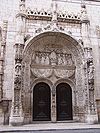Estrela Basilica
| Basílica da Estrela | |
|---|---|
 View of the main façade of the basilica dedicated to the Sacred Heart of Jesus situated in Lisbon, Portugal. | |
| Religion | |
| Affiliation | Roman Catholic |
| District | Lisbon District |
| Region | Lisboa Region |
| Rite | Latin Rite |
| Location | |
| Location | Praça da Estrela, 1200-667 Lisbon, Portugal |
| Municipality | Lisbon |
| Architecture | |
| Style | Baroque Neoclassical |
| Groundbreaking | 1779 |
| Completed | 1790 |
The Estrela Basilica (Portuguese: Basílica da Estrela), or Royal Basilica and Convent of the Most Sacred Heart of Jesus, is a basilica and ancient carmelite convent in Lisbon, Portugal, built by order of Queen Maria I of Portugal, as a fulfilled promise for giving birth to a son (José, Prince of Brazil). The official name of the church is the Basilica of the Sacred Heart of Jesus. Construction started in 1779 and the basilica was finished in 1790, after the death of José caused by smallpox in 1788.
The Estrela Basilica was the first church in the world dedicated to the Sacred Heart of Jesus.
Architecture
The huge church has a giant dome, and is located in a hill in what was at the time the western part of Lisbon and can be viewed from far away. The style is similar to the Mafra National Palace, in late baroque and neoclassical. The front has two twin bell towers and includes statues of saints and some allegoric figures.
A large quantity of grey, pink and yellow marble was used in the floor and walls, in intricate geometric patterns, one of the most beautiful in European churches. Several paintings by Pompeo Batoni also contribute to a balanced design. The tomb of the Queen Mary I is on the right transept. A famous nativity scene made by sculptor Joaquim Machado de Castro, with more than 500 figures in cork and terra cotta is a major attraction to visitors.
See also
- St. George's Anglican Church - located nearby

